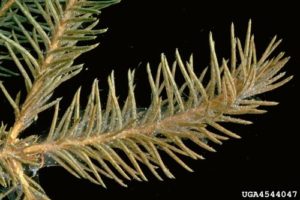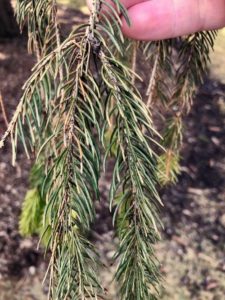Early Spring Pests Spruce Spider Mites

Figure 2: Webbing and excessive feeding damage on the terminal growth point of a spruce.(Source: USDA)
What is it:
The Spruce Spider Mite (Oligonychus ununguis) is a nearly microscopic pest that is closer related to spiders than true insects. This pest is a common feeder on most evergreens but is a major pest of both Arbor Vitae (Thuja occidentalis) and Colorado Blue Spruce (Picea pungens). These pests are nearly always present at low levels as part of a healthy ecosystem, and a healthy plant can thrive regardless of light feeding. However, unchecked their populations can quickly grow and cause significant damage to their host plant. This damage is often made worse when the host plant is under stress caused by poor cultural and environmental conditions.
The most common symptom is a stippled look to infested needles (Figure 1) caused by damage from their feeding. Spider mites feed on the chlorophyll found in plant cells and leave behind a creamy white spot wherever they feed. A single generation from egg to adult takes only 15-20 days, so this pest can rapidly outpace other beneficial insects keeping its’ population in check. An excessive population will leave fine webbing wherever they feed (Figure 2) and can cause dulling and premature drop of the host plants’ needles.

Figure 1: Typical stippling damage from Spruce Spider Mites on Norway Spruce. Heavier infestations will cause significant dulling of the needles and premature needle-drop.(Source: NJTE)
When and Where to find it:
This pest is a cool-season mite meaning it is active during the spring and fall, but the warm temperatures of the summer push it to dormancy. Look for activity to start in early April, as the Saucer Magnolia (Magnolia x soulangeana) comes into full bloom. Most commonly this pest is found on Colorado Blue Spruce and Arbor Vitae but can also be found feeding on Norway Spruce (Picea abies) and If you’re having a hard time seeing the common symptoms, a simple “smear test” help identify their presence. Hold a white piece of paper under the infested branch and shake the branch. Any mites present on the branch will fall to the paper. Next, smear your hand across the paper. If there are green streaks (indicating feeding on the plant), you have spider mites. If you have red streaks this is indicative of beneficial spider mites, who feed on the bad mites and keep their populations in check. Beneficial spider mites tend to be larger, visible with the naked eye and are bright red in color.
How to Treat it:
On the average healthy tree, no intervention is necessary. Light populations of spider mites do not significantly impede a trees’ ability to function normally. If you do notice excessive feeding or webbing on the plant, it may be time to treat. Several options are available, including miticide applications and horticultural oil sprays. Timing for miticide application is tight and must be applied when feeding is active in April or September/October. Horticultural oils control the dormant pests and therefore can be sprayed anytime during the spring or fall. However, some evergreens are sensitive to oil sprays and may go off-color if misapplied. Additionally, if you find beneficial mites on the host plant, you may want to hold off on treatment. Any spray that treats for Spruce Spider Mite will also knockdown any beneficial mites present and can exacerbate the problem. If you’re concerned about spider mite damage, it’s best to have you Nels Johnson Arborist decide which course of action is appropriate.
If you think you have spider mites, contact a Nels Johnson Arborist today for a free consultation.
